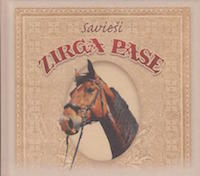The past years have brought many thematic Latvian folk song collections – from albums about the winter solstice (from the groups Laiksne and Vecpilsētas dziedātāji) to weddings (Iļģi), even funersals (Skandinieki) and sauna music (Iļģi again). This is not that surprising, as Latvians had songs for just about every occasion and about most every topic.
Continuing on that thematic approach, the Rīga-based women’s folk group Savieši released the album Zirga pase – an album collecting songs about horses. In previous centuries, few animals were as important to a Latvian as a horse, and, consequently, many folk songs mention the “kumeļš” or “kumeliņš”. Recognizing the great wealth of songs about the horse, Savieši have gathered horse-related folk songs from all over Latvia.
Savieši is a large (approximately twenty members) traditional folk ensemble that was founded in 1980, and is led by Ērika Māldere and musical director Amanda Jātniece. The songs presented on Zirga pase are almost entirely vocal based, with minimal accompaniment. Unlike other folk groups which include more modern elements and instruments, Savieši look to present an authentic Latvian folk performance. For the most part, the songs on the album are from the obscure end of the folk song spectrum, which will make this album a revelation for many listeners.
As Savieši is an all-female ensemble (though the men periodically help out with vocals and instruments on some of the songs), it is not particularly surprising that many of the songs chosen for this collection are from the female perspective. For example, “Es bagāta mātes meita”, a song about the daughter of a rich mother who had nine horses. This performance, in the Latvian call-response folk song style, reflects the authentic, purely vocal style of many of the songs on the album. Each song also has ethnographic notes on where the song originated from – both the melody and text. Also, the notes lists who is the lead caller (or callers) on each song; in this case it is Sarmīte Sedliņa.
Folk songs often had wise and sage advice, such as “Es jums teikšu, jauni zēni” (melody from Vecpiebalga, but text recorded in Lielpaltone and Džūkste), which exhorts young men to not only avoid purchasing a white horse, but also to forgo marrying a beautiful wife – as the white horse needs to be cleaned often, but the pretty wife needs to be protected.
Songs from the Latgale region are also included in this collection, such as “Aiz Daugavys august kolni”. This time, the men take the calling role (on this song, it is Gatis Ikaunieks and Kārlis Zemītis), in this story of a poor boy who sees a horse swimming in the sea, and receives a gold and silver saddle which then allows him to carry the daughters of the Sun across the sea.
One of the few songs with instrumentation is “Melni muni kumeleņi”, a tender song about a young man who is faced with a dilemma – who should his sister marry – the ploughman or the silversmith? Being a very practical person, he believes the ploughman is the better choice, as the silversmith is likely unable to bake bread on his own (and will need to come the ploughman to ask for bread).
Besides being a collection of folk songs about horses, the album is also meant as a detailed overview of the types of horses in Latvia, and even has a foldout poster that details with color drawings the various types of horse coat colors and designs (prepared by Agnese Kokina) – such as “dābolains” with larger spots and “ziedains” with small spots, and various degrees of darker colors – not just simply “bērs” but also “dūkanbērs”, “tumši bērs” and “dzidri bērs”. In fact, in Latvian there are 478 different ways of describing horses (by way of comparison, the Lithuanian language has only 159). The CD package itself – presented as a hardbound book – includes Inese Tome’s extensive research of Latvian horses. At almost 90 pages, the book includes detailed notes in Latvian and English about Latvian horse history, the various colors and even various horse related folk beliefs – such as “if you see a black horse in your dreams, then you will get very sick”.
Horses were an integral part of daily life in Latvia in centuries past, and, on Zirga pase, Savieši present a fitting and lovingly prepared tribute to the animals. Besides the authentic and genuine performances of these rarely heard melodies and texts, the album also provides for a fascinating study of the animal itself in an exquisitely detailed package. With their simple yet effective arrangements, Savieši have compiled an enjoyable and absorbing musical journey through Latvian traditions and beliefs.
For further information please visit the Savieši Facebook page.
Zirga pase
Savieši
Lauska, 2015
Track listing
- Es bagāta mātes meita
- Brālīt, tavu kumeliņu
- Aun, meitiņa, balti kājas
- Ņem, Jānīti, bēru zirgu
- Dzeltains manis kumeliņis
- Bāliņš jūdza, tautiets jūdza
- Baltus zirgus nejūdzati
- Man bij daiļis arājiņis
- Jauni puiši, syrmi zirgi
- Pērkonītis augstu brauca
- Pieci bēri kumeliņi
- Es jums teikšu, jauni zēni
- Kur tu brauci, rudzu Jumi
- Aiz Daugavys augsti kolni
- Melni muni kumeleņi
- Ne ošam tādas lapas
© 1995-2024 Latvians Online
Please contact us for editorial queries, or for permission to republish material. Disclaimer: The content of Web sites to which Latvians Online provides links does not necessarily reflect the opinion of Latvians Online, its staff or its sponsors.





